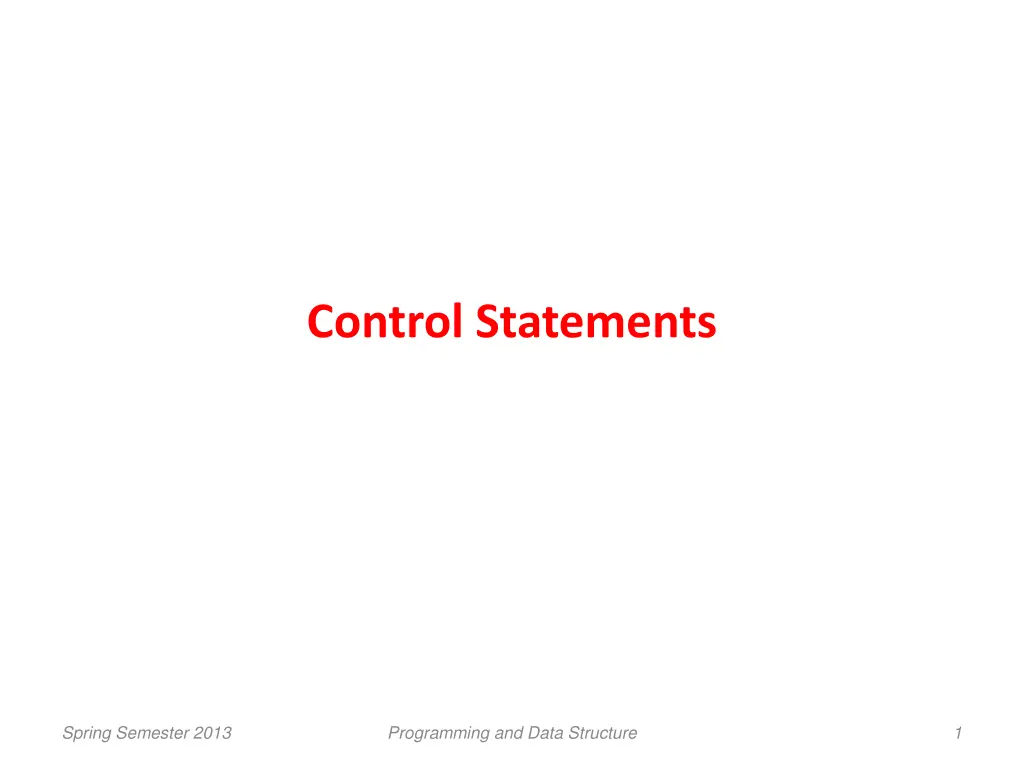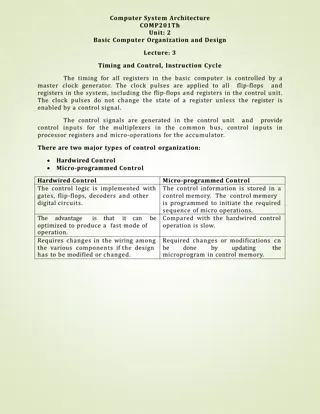
Understanding Control Statements in Programming
Learn about control statements in programming and how they allow different sets of instructions to be executed based on logical conditions. Discover how to specify conditions using relational and logical operators, along with examples and explanations of how conditions evaluate in programming.
Download Presentation

Please find below an Image/Link to download the presentation.
The content on the website is provided AS IS for your information and personal use only. It may not be sold, licensed, or shared on other websites without obtaining consent from the author. If you encounter any issues during the download, it is possible that the publisher has removed the file from their server.
You are allowed to download the files provided on this website for personal or commercial use, subject to the condition that they are used lawfully. All files are the property of their respective owners.
The content on the website is provided AS IS for your information and personal use only. It may not be sold, licensed, or shared on other websites without obtaining consent from the author.
E N D
Presentation Transcript
Control Statements Spring Semester 2013 Programming and Data Structure 1
What do they do? Allow different sets of instructions to be executed depending on the outcome of a logical test. Whether TRUE or FALSE. This is called branching. Some applications may also require that a set of instructions be executed repeatedly, possibly again based on some condition. This is called looping. Spring Semester 2013 Programming and Data Structure 2
How do we specify the conditions? Using relational operators. Four relation operators: Two equality operations: Using logical operators / connectives. Two logical connectives: Unary negation operator: <, <=, >, >= ==, != &&, | | ! Spring Semester 2013 Programming and Data Structure 3
Examples count <= 100 (math+phys+chem)/3 >= 60 (sex== M ) && (age>=21) (marks>=80) && (marks<90) (balance>5000) | | (no_of_trans>25) ! (grade== A ) ! ((x>20) && (y<16)) Spring Semester 2013 Programming and Data Structure 4
The conditions evaluate to Zero Indicates FALSE. Non-zero Indicates TRUE. Typically the condition TRUE is represented by the value 1 . Spring Semester 2013 Programming and Data Structure 5
Branching: The if Statement Diamond symbol (decision symbol) - indicates decision is to be made. Contains an expression that can be TRUE or FALSE. Test the condition, and follow appropriate path. Single-entry / single-exit structure. General syntax: if (condition) { .. } If there is a single statement in the block, the braces can be omitted. Spring Semester 2013 Programming and Data Structure 6
The if Selection Structure true grade >= 60 print Passed A decision can be made on any expression. zero - false false nonzero - true if (grade>=60) printf( Passed \n ); Spring Semester 2013 Programming and Data Structure 7
Example #include <stdio.h> main() { int a,b,c; scanf ( %d %d %d , &a, &b, &c); if ((a>=b) && (a>=c)) printf ( \n The largest number is: %d , a); if ((b>=a) && (b>=c)) printf ( \n The largest number is: %d , b); if ((c>=a) && (c>=b)) printf ( \n The largest number is: %d , c); } Spring Semester 2013 Programming and Data Structure 8
Branching: The if-else Statement Also a single-entry / single-exit structure. Allows us to specify two alternate blocks of statements, one of which is executed depending on the outcome of the condition. General syntax: if (condition) { block 1 . } else { .. block 2 .. } If a block contains a single statement, the braces can be deleted. Spring Semester 2013 Programming and Data Structure 9
The if/else Selection Structure false true grade >= 60 print Passed print Failed if ( grade >= 60 ) printf( "Passed\n"); else printf( "Failed\n"); Spring Semester 2013 Programming and Data Structure 10
if-else syntax if ( expression ) { statement_1; statement_2; . statement_n; } else { Statement_1; . Statement_m; } if ( grade >= 60 ) printf( "Passed\n"); else printf( "Failed\n"); if ( expression ) { statement1; statement2; . statement_n; } if (grade>=60) printf( Passed \n ); Spring Semester 2013 Programming and Data Structure 11
Nesting of if-else Structures It is possible to nest if-else statements, one within another. All if statements may not be having the else part. Confusion?? Rule to be remembered: An else clause is associated with the closest preceding unmatched if . Spring Semester 2013 Programming and Data Structure 12
if e1 s1 else if e2 s2 if e1 s1 else if e2 s2 else s3 ? if e1 if e2 s1 else s2 else s3 if e1 if e2 s1 else s2 Spring Semester 2013 Programming and Data Structure 13
if e1 s1 else if e2 s2 if e1 s1 else if e2 s2 if e1 s1 else if e2 s2 else s3 if e1 s1 else if e2 s2 else s3 if e1 if e2 s1 else s2 else s3 if e1 if e2 s1 else s2 else s3 if e1 if e2 s1 else s2 if e1 if e2 s1 else s2 Spring Semester 2013 Programming and Data Structure 14
Example #include <stdio.h> main() { int a,b,c; scanf ( %d %d %d , &a, &b, &c); if (a>=b) if (a>=c) printf ( \n The largest number is: %d , a); else printf ( \n The largest number is: %d , c); else if (b>=c) printf ( \n The largest number is: %d , b); else printf ( \n The largest number is: %d , c); } Spring Semester 2013 Programming and Data Structure 15
Example #include <stdio.h> main() { int a,b,c; scanf ( %d %d %d , &a, &b, &c); if ((a>=b) && (a>=c)) printf ( \n The largest number is: %d , a); else if (b>c) printf ( \n The largest number is: %d , b); else printf ( \n The largest number is: %d , c); } Spring Semester 2013 Programming and Data Structure 16
Confusing Equality (==) and Assignment (=) Operators Dangerous error Does not ordinarily cause syntax errors Any expression that produces a value can be used in control structures Nonzero values are true, zero values are false Example: if ( payCode == 4 ) printf( "You get a bonus!\n" ); Checks paycode, if it is 4 then a bonus is awarded Equality check improper if ( payCode = 4 ) printf( "You get a bonus!\n" ); Equality check proper if ( payCode == 4 ) printf( "You get a bonus!\n" ); Spring Semester 2013 Programming and Data Structure 18
Generalization of expression evaluation in C Assignment (=) operation is also a part of expression. i=3; Returns the value 3 after assigning it to i. int i=4, j ; int i=4, j ; j? if(i=3) j=0; else j=1; if(i==3) j=0; else j=1; Whatever be the value of i, j is always 0. j=1 Spring Semester 2013 Programming and Data Structure 19
More about expressions Increment (++) and Decrement (--)Operations --i; ++i; Prefix operation First increment / decrement and then used in evaluation i++; i--; Postfix operation increment / decrement operation after being used in evaluation int t,m=1; int t,m=1; m=2; t=2; m=2; t=1; t=++m; t=m++; Spring Semester 2013 Programming and Data Structure 20
Some More Examples Initial values :: a = 10; b = 20; x = 50 + ++a; a = 11, x = 61 x = 50 + a++; x = 60, a = 11 x = a++ + --b; b = 19, x = 29, a = 11 x = a++ ++a; Undefined value (implementation dependent) Spring Semester 2013 Programming and Data Structure 21
Ternary conditional operator (?:) Takes three arguments (condition, value if true, value if false) Returns the evaluated value accordingly. grade >= 60 ? printf( Passed\n ) : printf( Failed\n ); (expr1)? (expr2): (expr3); Example: interest = (balance>5000) ? balance*0.2 : balance*0.1; Returns a value Spring Semester 2013 Programming and Data Structure 22
The switch Statement This causes a particular group of statements to be chosen from several available groups. Uses switch statement and case labels. Syntax of the switch statement: switch (expression) { case expression-1: { .. } case expression-2: { .. } case expression-m: { .. } default: { } } Spring Semester 2013 Programming and Data Structure 23
The switch Multiple-Selection Structure true case a case a action(s) break false true case b case b action(s) break false . . . true case z case z action(s) break false default action(s) Spring Semester 2013 Programming and Data Structure 24
Example switch ( letter ) { case 'A': case 'Z': default : } printf("First letter\n"); break; printf("Last letter\n"); break; printf("Middle letter\n"); break; Spring Semester 2013 Programming and Data Structure 25
Example switch (choice = toupper(getchar())) { case R : case G : case B : default: printf ( RED \n ); break; printf ( GREEN \n ); break; printf ( BLUE \n ); break; printf ( Invalid choice \n ); } Spring Semester 2013 Programming and Data Structure 26
Example switch (choice = getchar()) { case r : case R : case g : case G : case b : case B : default: printf ( RED \n ); break; printf ( GREEN \n ); break; printf ( BLUE \n ); break; printf ( Invalid choice \n ); } Spring Semester 2013 Programming and Data Structure 28
The break Statement Used to exit from a switch or terminate from a loop. Already illustrated in the switch examples. With respect to switch , the break statement causes a transfer of control out of the entire switch statement, to the first statement following the switch statement. Spring Semester 2013 Programming and Data Structure 29
The Essentials of Repetition Loop Group of instructions computer executes repeatedly while some condition remains true Counter-controlled repetition Definite repetition - know how many times loop will execute Control variable used to count repetitions Sentinel-controlled repetition Indefinite repetition Used when number of repetitions not known Sentinel value indicates "end of data" Spring Semester 2013 Programming and Data Structure 30
Counter-Controlled Repetition Counter-controlled repetition requires name of a control variable (or loop counter). initial value of the control variable. condition that tests for the final value of the control variable (i.e., whether looping should continue). increment (or decrement) by which the control variable is modified each time through the loop. int counter =1; //initialization while (counter <= 10) { //repetition condition printf( "%d\n", counter ); ++counter; //increment } Spring Semester 2013 Programming and Data Structure 31
Counter-Controlled Repetition Counter-controlled repetition requires name of a control variable (or loop counter). initial value of the control variable. condition that tests for the final value of the control variable (i.e., whether looping should continue). increment (or decrement) by which the control variable is modified each time through the loop. int counter; for (counter=1;counter<=10;counter++) printf( %d\n ,counter); Spring Semester 2013 Programming and Data Structure 32
while Statement while (condition) statement_to_repeat; /* Weight loss program */ while ( weight > 65 ) { printf("Go, exercise, "); printf("then come back. \n"); printf("Enter your weight: "); scanf("%d", &weight); } while (condition) { statement_1; ... statement_N; } int digit = 0; while (digit <= 9) printf ( %d \n , digit++); Spring Semester 2013 Programming and Data Structure 33
false C Single-entry / single-exit structure true statement(s) Spring Semester 2013 Programming and Data Structure 34
do-while Statement do { statement-1 statement-2 . . statement-n /* Weight loss program */ do { printf("Go, exercise, "); printf("then come back. \n"); printf("Enter your weight: "); scanf("%d", &weight); } while ( weight > 65 ) ; } while (condition); At least one round of exercise ensured. Spring Semester 2013 Programming and Data Structure 35
statement(s) Single-entry / single-exit structure false C int digit = 0; true do printf ( %d \n , digit++); while (digit <= 9); Spring Semester 2013 Programming and Data Structure 36
for Statement for (initial; condition; iteration) statement_to_repeat; All are expressions. initial expr1 condition expr2 iteration expr3 for (initial; condition; iteration) { statement_1; ... statement_N; } fact = 1; /* Calculate 10 ! */ for ( i = 1; i < =10; i++) fact = fact * i; No semicolon after last expression Spring Semester 2013 Programming and Data Structure 37
How it works? expression1 is used to initialize some variable (called index) that controls the looping action. expression2 represents a condition that must be true for the loop to continue. expression3 is used to alter the value of the indexinitially assigned by expression1 . int digit; for (digit=0; digit<=9; digit++) printf ( %d \n , digit); Spring Semester 2013 Programming and Data Structure 38
How it works? expression1 is used to initialize some variable (called index) that controls the looping action. expression2 represents a condition that must be true for the loop to continue. expression3 is used to alter the value of the indexinitially assigned by expression1 . Spring Semester 2013 Programming and Data Structure 39
int digit; expression1 for (digit=0; digit<=9; digit++) printf ( %d \n , digit); false expression2 Single-entry / single-exit structure true statement(s) expression3 Spring Semester 2013 Programming and Data Structure 40
The For Structure: Notes and Observations Arithmetic expressions Initialization, loop-continuation, and increment can contain arithmetic expressions. e.g. Let x = 2 and y = 10 for ( j = x; j <= 4 * x * y; j += y / x ) Increment Initialization is equivalent to Loop continuation for ( j = 2; j <= 80; j += 5 ) "Increment" may be negative (decrement) If loop continuation condition initially false Body of for structure not performed Control proceeds with statement after for structure Spring Semester 2013 Programming and Data Structure 41
for :: Examples int fact = 1, i; int sum = 0, N, count; for (i=1; i<=10; i++) fact = fact * i; scanf ( %d , &N); for (i=1; i<=N, i++) sum = sum + i * i; printf ( %d \n , sum); Spring Semester 2013 Programming and Data Structure 42
The comma operator We can give several statements separated by commas in place of expression1 , expression2 , and expression3 . for (fact=1, i=1; i<=10; i++) fact = fact * i; for (sum=0, i=1; i<=N, i++) sum = sum + i * i; Spring Semester 2013 Programming and Data Structure 43
Specifying Infinite Loop for (; ;) { statements } while (1) { statements } do { statements } while (1); Spring Semester 2013 Programming and Data Structure 44
break Statement Break out of the loop { } can use with while do while for switch does not work with if {} else {} Causes immediate exit from a while, for, do/while or switch structure Program execution continues with the first statement after the structure Common uses of the break statement Escape early from a loop Skip the remainder of a switch structure Spring Semester 2013 Programming and Data Structure 45
A Complete Example #include <stdio.h> main() { int fact, i; fact = 1; i = 1; } while ( i<10 ) { fact = fact * i; if ( fact > 100 ) { } i ++ ; } /* run loop break when fact >100*/ printf ("Factorial of %d above 100", i); break; /* break out of the while loop */ Spring Semester 2013 Programming and Data Structure 46
continue Statement continue Skips the remaining statements in the body of a while, for or do/while structure Proceeds with the next iteration of the loop while and do/while Loop-continuation test is evaluated immediately after the continue statement is executed for structure Increment expression is executed, then the loop-continuation test is evaluated. expression3 is evaluated, then expression2 is evaluated. Spring Semester 2013 Programming and Data Structure 47
An Example with break & continue fact = 1; i = 1; while (1) { fact = fact * i; i ++ ; if ( i<10 ) break; } /* a program to calculate 10 ! continue; /* not done yet ! Go to loop and perform next iteration*/ Spring Semester 2013 Programming and Data Structure 48
Some Examples Spring Semester 2013 Programming and Data Structure 49
Example 1: Test if a number is prime or not #include <stdio.h> main() { int n, i=2; scanf ( %d , &n); while (i < n) { if (n % i == 0) { } i++; } printf ( %d is a prime \n , n); } printf ( %d is not a prime \n , n); exit; Spring Semester 2013 Programming and Data Structure 50
More efficient?? #include <stdio.h> main() { int n, i=3; scanf ( %d , &n); while (i < sqrt(n)) { if (n % i == 0) { } i = i + 2; } printf ( %d is a prime \n , n); } printf ( %d is not a prime \n , n); exit; Spring Semester 2013 Programming and Data Structure 51
Example 2: Find the sum of digits of a number #include <stdio.h> main() { int scanf ( %d , &n); while (n != 0) { sum = sum + (n % 10); n = n / 10; } printf ( The sum of digits of the number is %d \n , sum); } n, sum=0; Spring Semester 2013 Programming and Data Structure 52






















